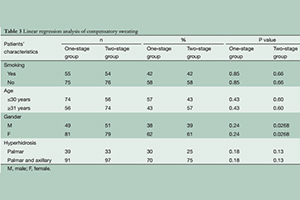Long term compensatory sweating results after sympathectomy for palmar and axillary hyperhidrosis
Abstract
Background: Endoscopic thoracic sympathectomy is currently the best treatment for primary upper extremity hyperhidrosis, but the potential for adverse effects, particularly the development of compensatory sweating, is a concern and often precludes surgery as a definitive therapy. This study aims to evaluate long-term results of two-stage unilateral versus one-stage bilateral thoracoscopic sympathectomy.
Methods: From November 1995 to February 2011, 261 patients with severe palmar and/or axillary hyperhidrosis underwent endoscopic sympathectomy with a follow-up of at least 4 years. One-hundred and twenty-six patients received one-stage bilateral, single port video-assisted thoracoscopic sympathectomy (one-stage group) and 135 patients underwent two-stage unilateral, single-port video-assisted thoracoscopic sympathectomy, with a mean time interval of four months between the procedures (two-stage group).
Results: The mean postoperative follow-up period was 7.2 years (range, 4–9 years). Sixteen patients (12.7%) in the one-stage group and 15 patients (11.1%) in the two-stage group suffered from bradycardia (P=0.15). Recurrences occurred in three patients (2.4%) in the one-stage group and one (0.7%) in the two-stage group (P=0,09). Facial flushing or hyperthermia occurred in eight patients (6.3%) in the one-stage group and 11 (8.1%) of the two-stage group. Compensatory sweating occurred in 27 patients (21.4%) in the one-stage group and six patients (4.4%) in the two-stage group (P=0.0001). However, compensatory sweating recovered in five patients (83.3%) in the two-stage group versus nine (33.35%) in one-stage group during the follow-up period (Log-rank test P=0.016; HR, 7.196; 95% CI, 1.431–36.20). An improvement in postoperative quality of life (QoL) scores was observed in at least 90% of patients at three years after surgery in the one-stage group and at least 95% of patients in the two-stage group (P=0.001).
Conclusions: Compensatory sweating seems to improve during the follow-up period with a higher recovery rate after two-stage unilateral versus one-stage bilateral sympathectomy for patients with palmar and axillary hyperhidrosis.
Cover






